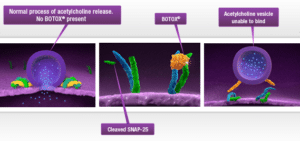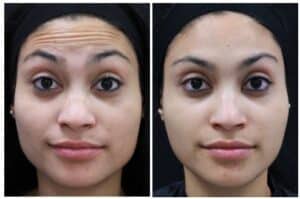Botox® Cosmetic Treatments
The use of wrinkle relaxers like Botox® has steadily increased over the last two decades and today are one of the most commonly performed cosmetic treatments in the world. However, most patients, at least the ones we see in Miami, do not know how Botox works.
What Is Botox Made Of?
Botox and its alternatives, Dysport and Xeomin, are made of botulinum toxin A. When injected into the face, Botox stops acetylcholine release at the nerve muscle junction by cleaving an important protein, SNAP-25, which is necessary for the release of acetylecholine (see pic 1). Acetycholine is required for a nerve to communicate with a muscle and to tell it to contract. By injecting Botox into the upper face, muscles like the frontalis, which form forehead lines, are relaxed (see pic 2 below).
The muscles most commonly treated with Botox are:
- The procerus and corrugators, responsible for frown lines
- The orbicularis oculi, responsible for crow’s feet
- The frontalis, responsible for forehead lines
Masseter Muscle Botox
The masseters are a muscle that helps with chewing. However, in patients who grind or clench their teeth, the muscle gets enlarged. Since the muscle inserts onto the jawbone at the posterior aspect of the jawline, it’s enlargement leads to squaring of the face and fullness of the lower face. Dr. Patel often injects Botox into the masseter muscle. The Botox prevents the masseter muscle from contracting and the muscle shrinks in size over time from disuse atrophy. The muscle atrophy is similar to the muscle atrophy seen when an arm is placed in a cast for months. When the cast is removed, the muscle has atrophied because it was not being used while in the cast.

Additional Botox Injection Sites
Other areas that we use Botox include the neck where the plastysma muscle is treated. Here too, Botox, stops acetylcholine release at the neuromuscular junction and this relaxes the platysma muscle which is responsible for neck bands and loss of jawline definition caused by a downward pull on the face. Botox is also used to treat the nasalis muscle (bunny lines), orbicularis oris (vertical lip lines, smokers’ lines, lipstick lines), and depressor anguli oris muscle (downturned corners of the mouth). In all of these cases, Botox relaxes the underlying muscle leading to associated aesthetic benefit.

